It looks like you're using an Ad Blocker.
Please white-list or disable AboveTopSecret.com in your ad-blocking tool.
Thank you.
Some features of ATS will be disabled while you continue to use an ad-blocker.
5
share:
From a now 404'd ATS thread, a poster was recanting a story involving a number of 2nd hand "sensitive" facts including something to the effect
of...
I found my inner sceptic's interest piqued over the specifics, did a little research and learned that this turns out to be absolutely correct.
What a great factoid to drop on ones conspiratorially like minded buddies during the weekly Friday night beer and b.s. meet at the local pub.
Here are the highlights...
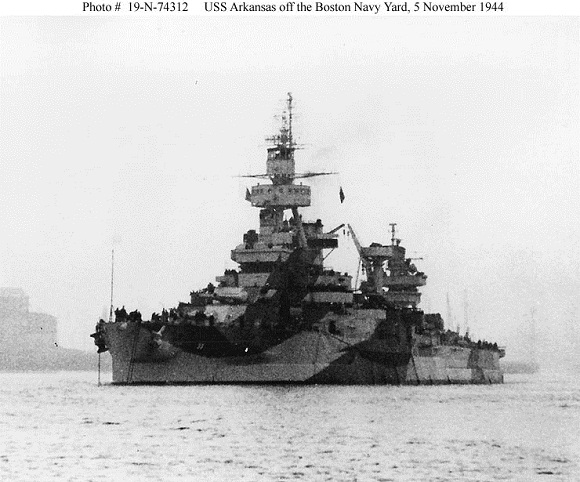 USS Arkansas (BB-33)Off the Boston Navy Yard,
Massachusetts, 5 November 1944.
USS Arkansas (BB-33)Off the Boston Navy Yard,
Massachusetts, 5 November 1944.
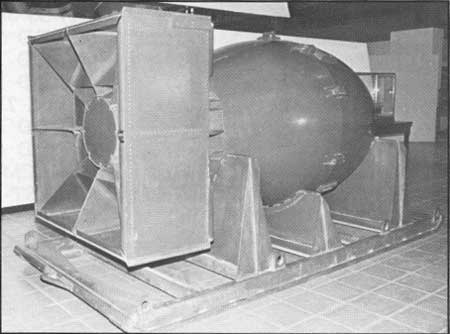 the Crossroads bombs were drawn from the U.S.
stockpile of nine implosion-type core devices; these weapons were nearly identical to the Mk III "Fat Man" bomb dropped on Nagasaki. These weapons
reportedly yielded a 23-kiloton effect, equal to 23,000 tons of TNT.
the Crossroads bombs were drawn from the U.S.
stockpile of nine implosion-type core devices; these weapons were nearly identical to the Mk III "Fat Man" bomb dropped on Nagasaki. These weapons
reportedly yielded a 23-kiloton effect, equal to 23,000 tons of TNT.
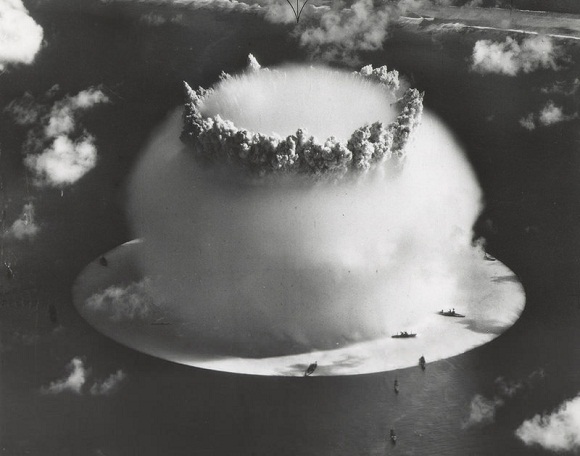 Crossroads Baker, showing the white surface "crack" under the ships, and the top of the hollow spray column protruding
through the hemispherical Wilson cloud. Bikini Island beach in the background.
Crossroads Baker, showing the white surface "crack" under the ships, and the top of the hollow spray column protruding
through the hemispherical Wilson cloud. Bikini Island beach in the background.
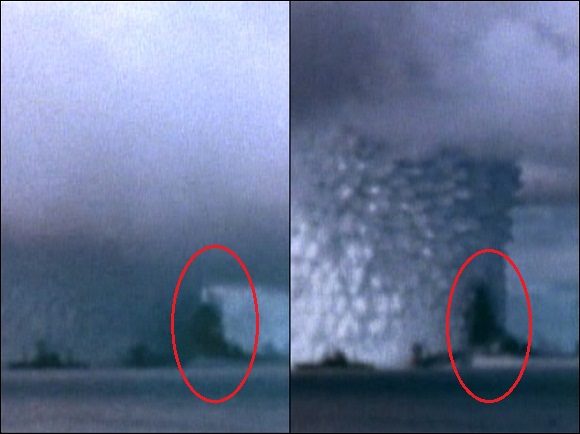 The Wilson cloud lifts, revealing a vertical black object, larger than ships in the foreground, which most observers
believed was the upended battleship Arkansas.
The Wilson cloud lifts, revealing a vertical black object, larger than ships in the foreground, which most observers
believed was the upended battleship Arkansas.
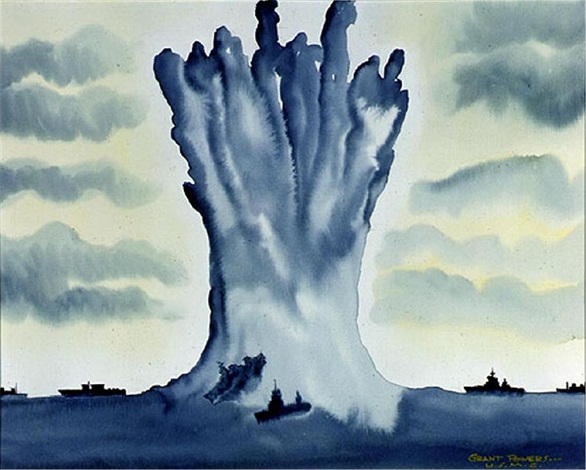 "Battleship Arkansas Being Tossed in Giant Pillar", watercolor by Grant Powers, U.S.M.C, 1946
"Battleship Arkansas Being Tossed in Giant Pillar", watercolor by Grant Powers, U.S.M.C, 1946
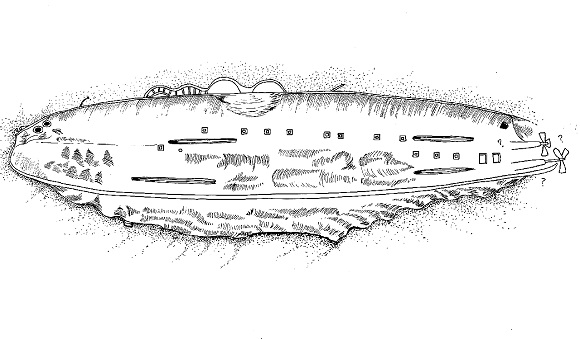 Battleship Arkansas upside down, 180 feet deep in Bikini Lagoon. Diver's sketch from a 1989 National Park Service
dive.
Battleship Arkansas upside down, 180 feet deep in Bikini Lagoon. Diver's sketch from a 1989 National Park Service
dive.
 Diver at Bow of USS Arkansas
Battleship
Diver at Bow of USS Arkansas
Battleship
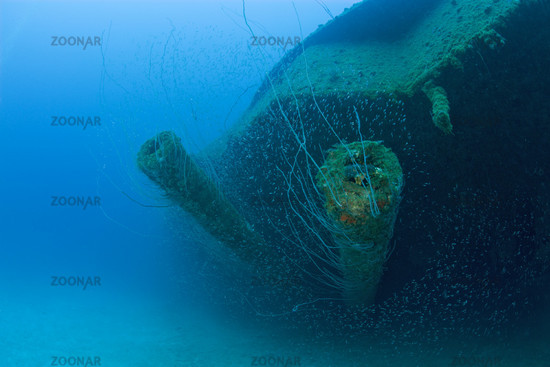 12-inch Gun of USS Arkansas
Battleship
12-inch Gun of USS Arkansas
Battleship
Enjoy
It takes a 22 kiloton nuclear explosion to split open a WWII battleship at the seams
I found my inner sceptic's interest piqued over the specifics, did a little research and learned that this turns out to be absolutely correct.
What a great factoid to drop on ones conspiratorially like minded buddies during the weekly Friday night beer and b.s. meet at the local pub.
Here are the highlights...
Operation Crossroads was a series of nuclear weapon tests conducted by the United States at Bikini Atoll in mid-1946.
It was the first test of a nuclear weapon after the Trinity nuclear test in July 1945, and the first detonation of any nuclear device following the Fat Man detonation on August 9, 1945. Its purpose was to investigate the effect of nuclear weapons on naval ships.
Crossroads consisted of two detonations, each with a yield of 23 kilotons: Able was detonated at an altitude of 520 feet (158 m) on July 1, 1946; Baker was detonated 90 feet (27 m) underwater on July 25, 1946...
Test Baker
In Baker on July 25, the weapon was suspended beneath landing craft LSM-60 anchored in the midst of the target fleet. Baker was detonated 90 feet (27 m) underwater, halfway to the bottom in water 180 feet (54 m) deep. How/Mike Hour was 0835.
No identifiable part of LSM-60 was ever found; it was presumably vaporized by the nuclear fireball. Ten ships were sunk, including the German heavy cruiser Prinz Eugen, which sank in December, five months after the test, because radioactivity prevented repairs to a leak in the hull.
Photographs of Baker are unique among nuclear detonation pictures. The blinding flash that usually obscures the target area took place underwater and was barely seen. The clear image of ships in the foreground and background gives a sense of scale.
The large Wilson cloud and the vertical water column are distinctive Baker shot features, making the pictures easily identifiable. The most notable picture shows a mark where the 27,000 ton battleship Arkansas was.





USS Arkansas (BB-33)
Arkansas was the closest ship to the bomb other than the ship from which it was suspended...
...Unattentuated by air, the shock was "transmitted directly to underwater hulls", and Arkansas, only 250 yards from the epicenter, appeared to have been "crushed as if by a tremendous hammer blow from below".
It appears that the wave of water from the blast capsized the ship, which was then hammered down into the shallow bottom by the descent of the water column thrown up by the blast...
....The underwater shock wave crushed the starboard side of her hull, which faced the bomb, and rolled the battleship over onto her port side. It also ripped off the two starboard side propellers and their shafts, along with the rudder and part of the stern, shortening the hull by 25 feet (7.6 m).
At 562 feet (171 m) long, the battleship was three times as long as the water is deep. When the Wilson cloud lifted, the Arkansas was apparently bow-pinned to the sea floor with her truncated stern 350 feet (110 m) in the air. Unable to sink straight down in the relatively shallow lagoon, she toppled backward into the water curtain of the spray column...
She was next seen by Navy divers, the same year, lying upside down with her bow on the rim of the underwater bomb crater and stern angled toward the center. There was no sign of the superstructure or the big guns...
...The Arkansas settled upside down, but a 1989 diver's sketch of the wreck shows hardly any of the starboard side of the hull, making it look like the ship is lying on her side. Most of the starboard side is there, but severely compacted.
The superstructure has not been found. It was either stripped off and swept away or is lying under the hull, crushed and buried under sand which flowed back into the crater, partially refilling it.



Enjoy
Cheers ! I enjoyed that thread, took me off on an internet wander of watching videos of nukes going off.
I was not lying when I related that. I gave the name and some real honest to God top secret info. I do not know why the thread was deleted. But
honestly, I was not lying. My facts were 100% correct. I never lie or make things up. What I write may seem far fetched quite often, but it is not a
lie and it is the truth.
Its interesting how the blast differs so much depending on where it is detonated. Thanks for sharing!
Originally posted by Ookie
I was not lying when I related that. I gave the name and some real honest to God top secret info. I do not know why the thread was deleted. But honestly, I was not lying. My facts were 100% correct. I never lie or make things up. What I write may seem far fetched quite often, but it is not a lie and it is the truth.
You were absolutely correct.
In fairness the bulk of your post seemed on the level although you must admit that 23kt is an oddly specific fact on what can be a very esoteric subject.
Thank you again for sharing that.
Originally posted by FawnyKate
Cheers ! I enjoyed that thread, took me off on an internet wander of watching videos of nukes going off.
They are amazing to watch although that was a different time, even underground testing has been banned by treaty for 30 years now.
Here are a couple of photos taken in the early 1960's from downtown Los Angeles showing the flash of a nuclear bomb being detonated at the Nevada Test Site, some 250 miles away!



Given that lazer guidance would mean that a nuclear weapon could be guided directly onto the deck of a ship these days, the yield would probably not
need to be so big. If the weapon were tipped with an armor nullifying tip, and detonated inside the skin of the vessel, a smaller device would crack
the hull and superheat the entire innards of the vessel without breaking a sweat I reckon.
the reason you would use a large nuke in a naval conflict would be to take out large group of ships at once like say a carrier battle group and in
situation like that an underwatter or a detonation in air would work best. same idea why 50s era interceptors carried nuke missiles for air to air to
hope to take out a large squadron with each ordinance used
new topics
-
Mike Pinder The Moody Blues R.I.P.
Music: 35 minutes ago -
Putin, Russia and the Great Architects of the Universe
ATS Skunk Works: 3 hours ago -
A Warning to America: 25 Ways the US is Being Destroyed
New World Order: 8 hours ago
top topics
-
President BIDEN's FBI Raided Donald Trump's Florida Home for OBAMA-NORTH KOREA Documents.
Political Conspiracies: 13 hours ago, 31 flags -
A Warning to America: 25 Ways the US is Being Destroyed
New World Order: 8 hours ago, 13 flags -
Is AI Better Than the Hollywood Elite?
Movies: 15 hours ago, 4 flags -
Mike Pinder The Moody Blues R.I.P.
Music: 35 minutes ago, 2 flags -
Maestro Benedetto
Literature: 15 hours ago, 1 flags -
Putin, Russia and the Great Architects of the Universe
ATS Skunk Works: 3 hours ago, 1 flags
active topics
-
Putin, Russia and the Great Architects of the Universe
ATS Skunk Works • 13 • : CriticalStinker -
Alternate Electors vs Fake Electors - What is the Difference.
2024 Elections • 120 • : Threadbarer -
Gaza Terrorists Attack US Humanitarian Pier During Construction
Middle East Issues • 58 • : matafuchs -
Truth Social goes public, be careful not to lose your money
Mainstream News • 132 • : matafuchs -
New whistleblower Jason Sands speaks on Twitter Spaces last night.
Aliens and UFOs • 67 • : Ophiuchus1 -
Mike Pinder The Moody Blues R.I.P.
Music • 1 • : RussianTroll -
Mood Music Part VI
Music • 3106 • : TheWoker -
University of Texas Instantly Shuts Down Anti Israel Protests
Education and Media • 275 • : Vermilion -
President BIDEN's FBI Raided Donald Trump's Florida Home for OBAMA-NORTH KOREA Documents.
Political Conspiracies • 22 • : 320MPH -
A Warning to America: 25 Ways the US is Being Destroyed
New World Order • 19 • : Cvastar
5
